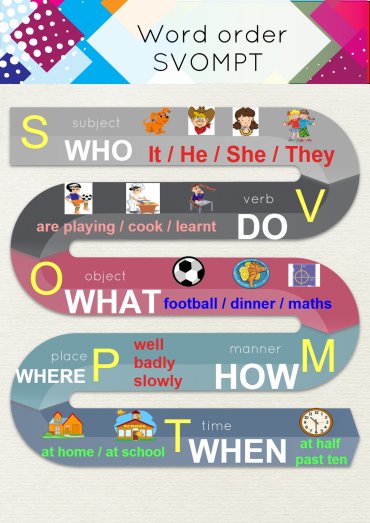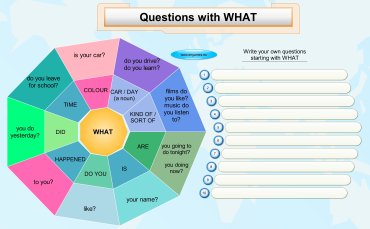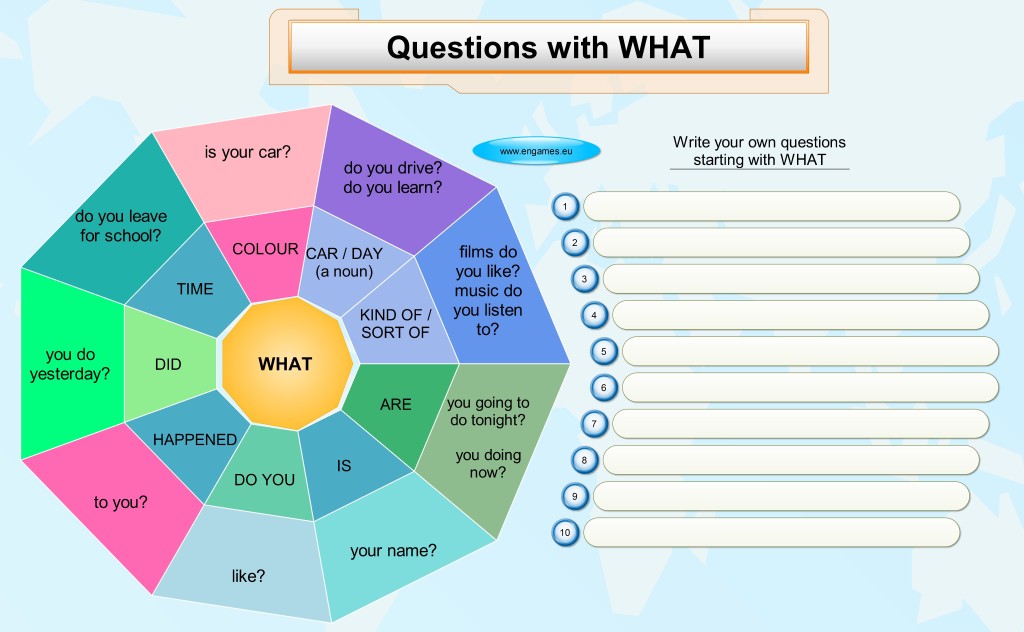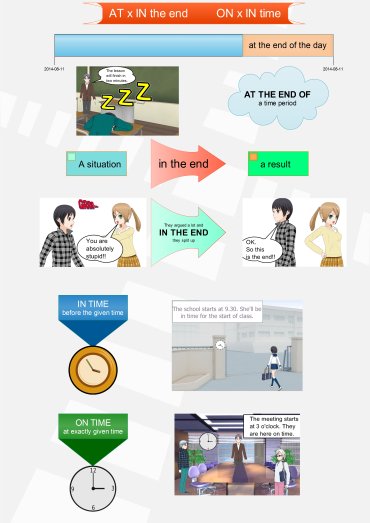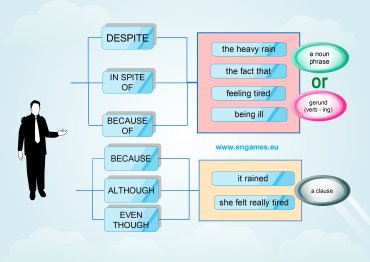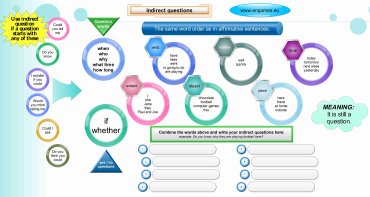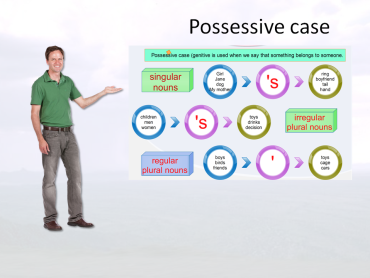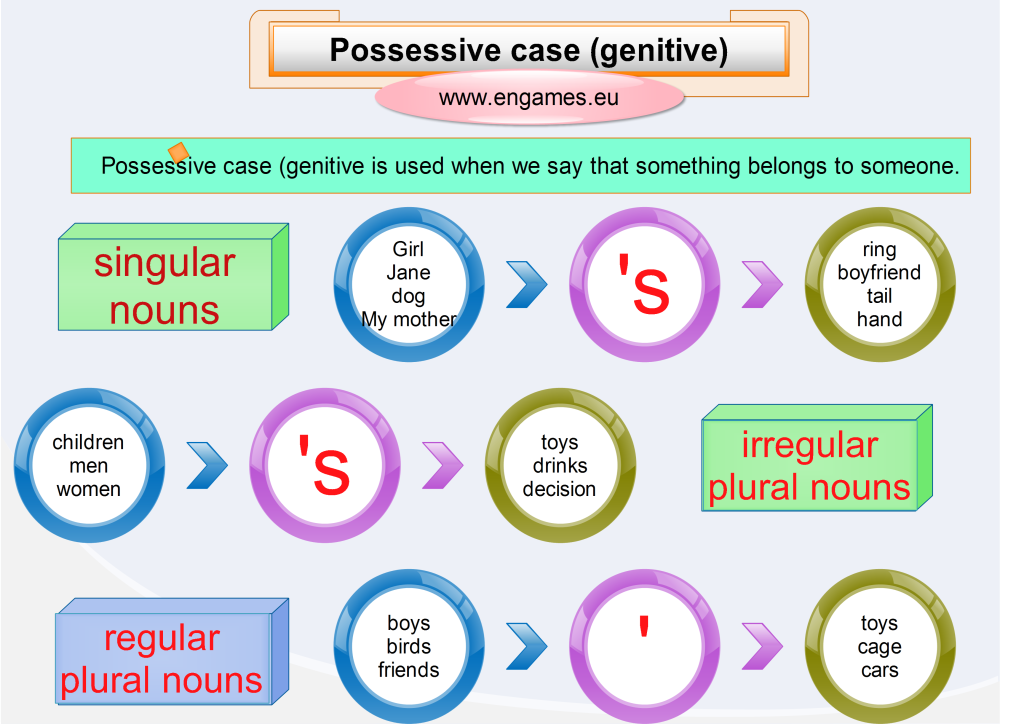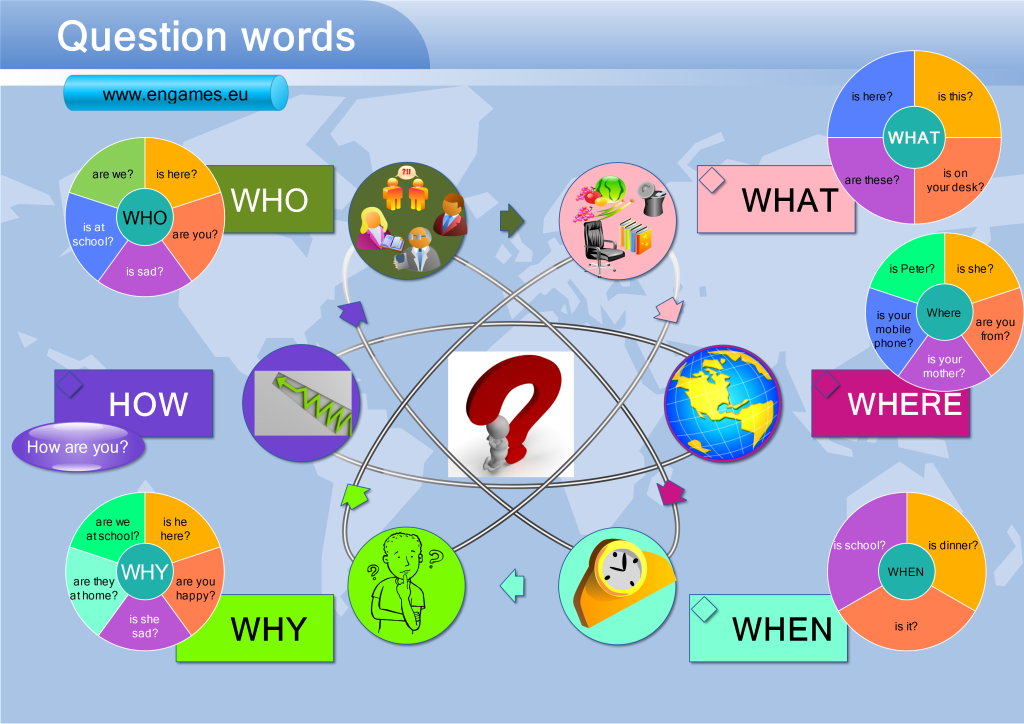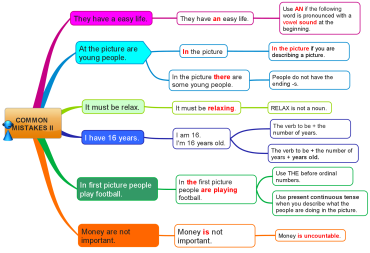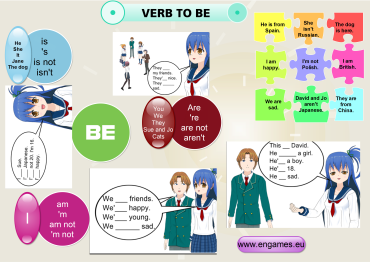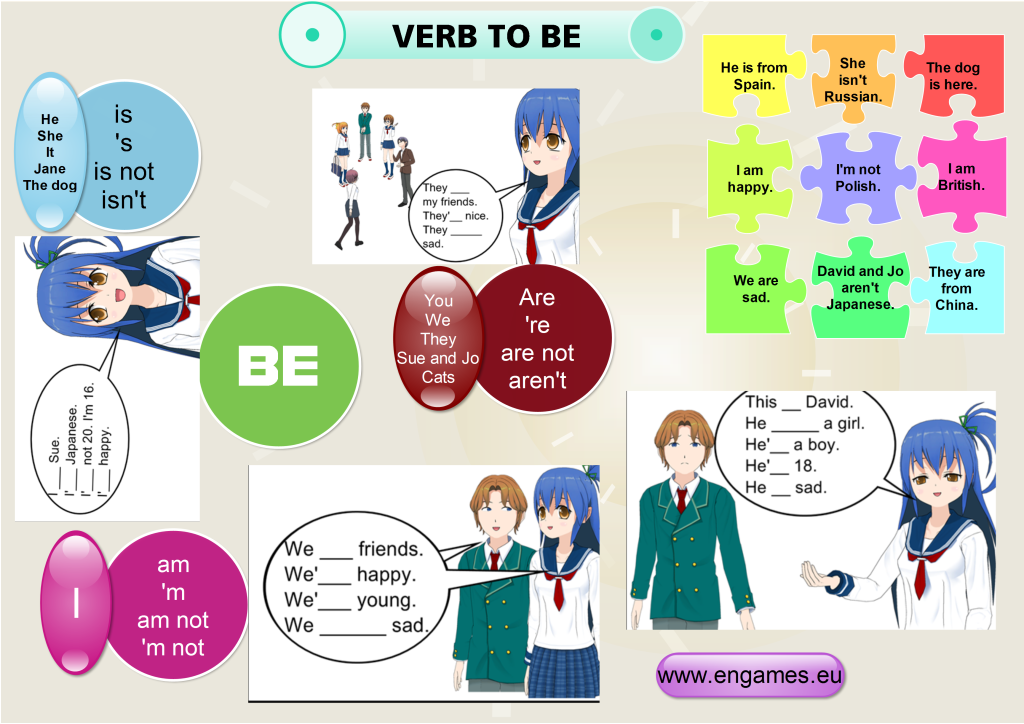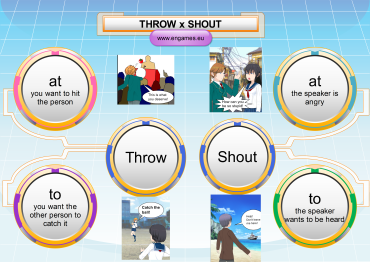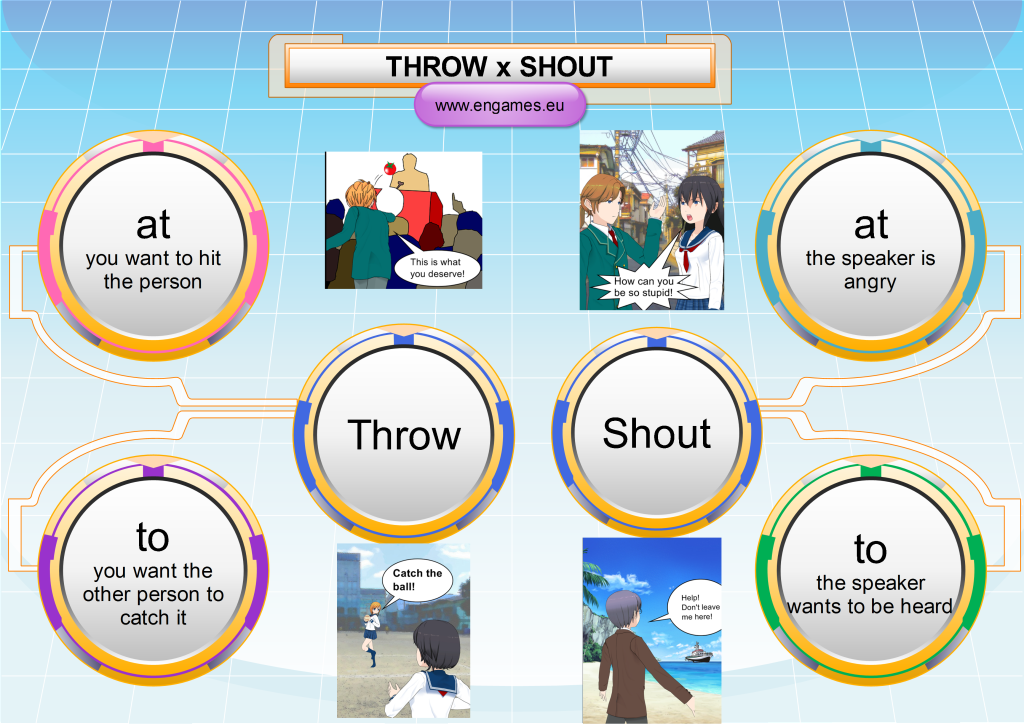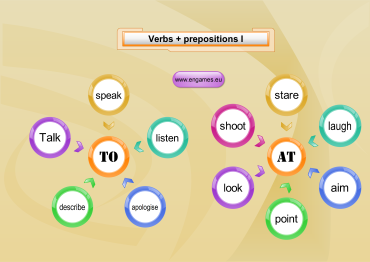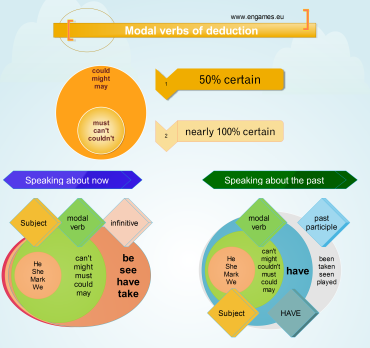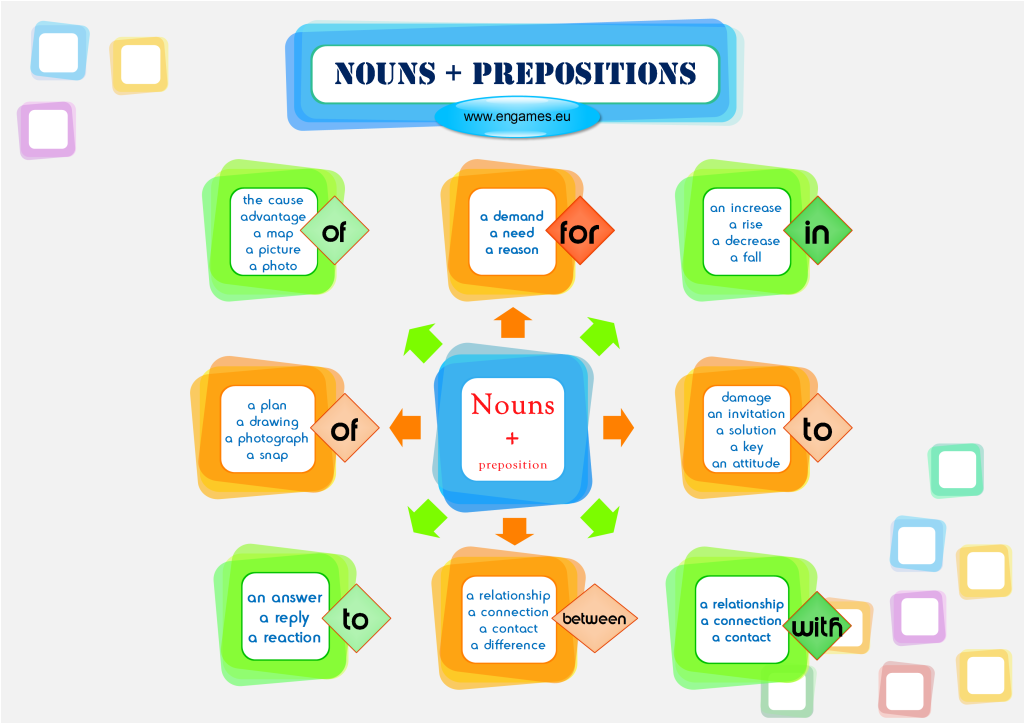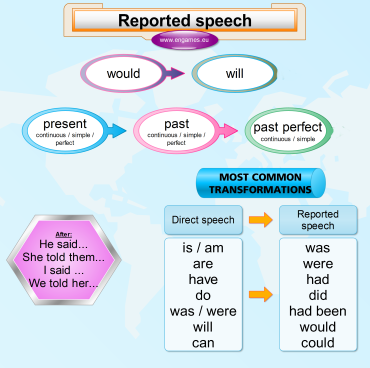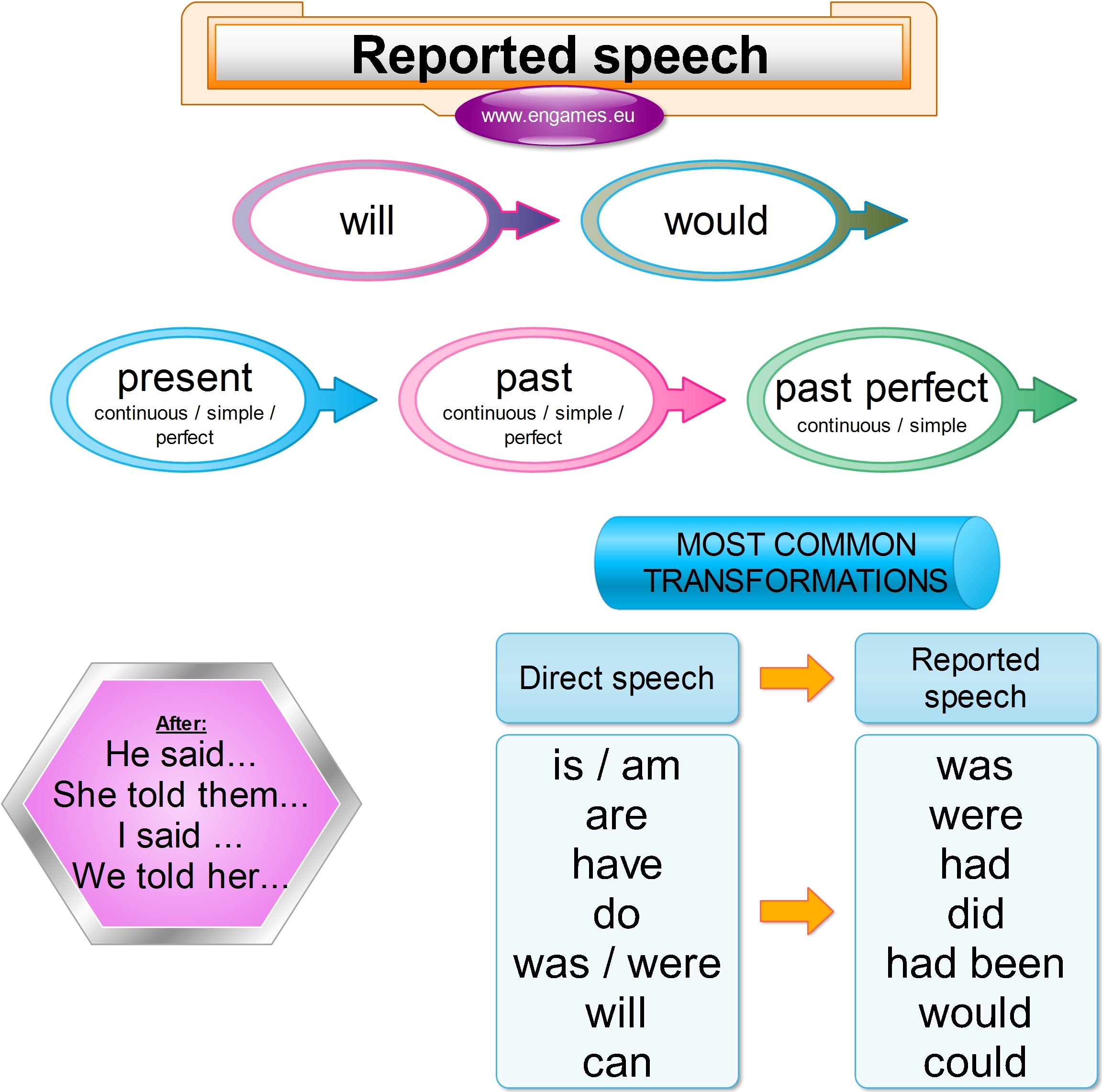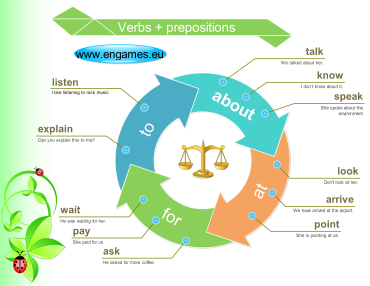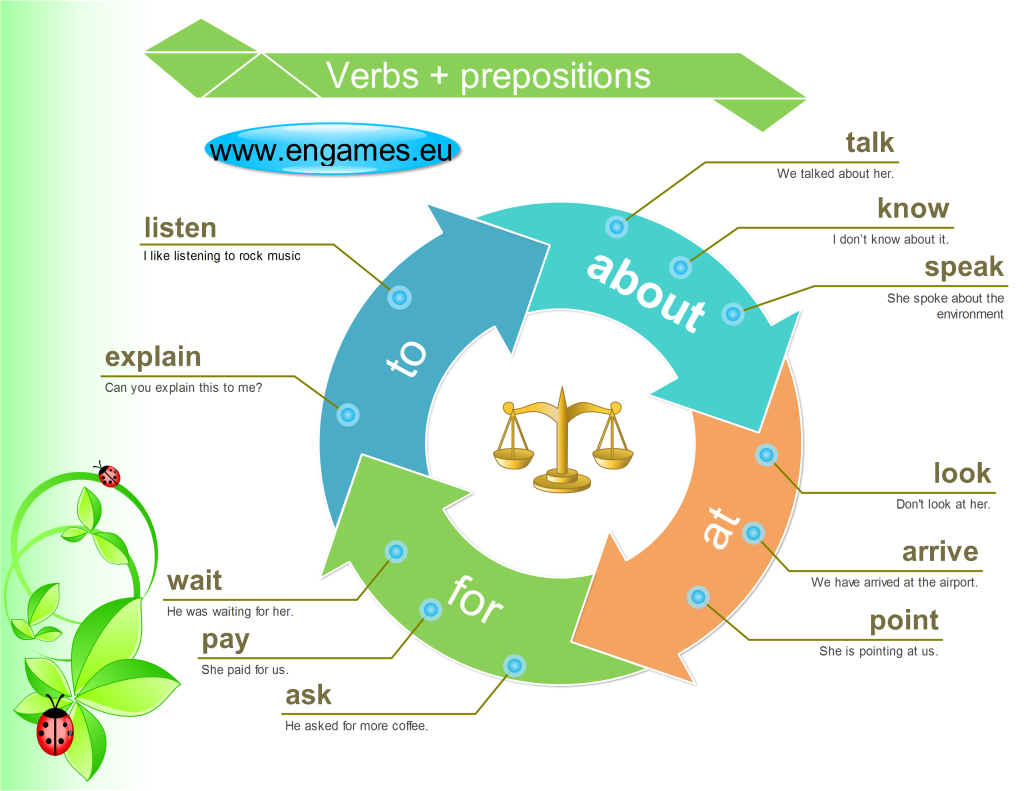SVOMPT rule is one of the most important rules in English. If students learn to follow this rule, their English will improve dramatically, and they will be understood. Once a student knows some words and follows the SVOMPT rule, we can say that he/she can speak English.
ADVERT:
[showmyads]
I love Darren Crown’s explanation of the origin of the SVOMPT word order. In his humorous book “Angličtina na rovinu” he writes that English was first used by a primitive tribe whose members did not want to use their brain too much and thus they created a word order which is always the same – Subject, Verb, Object, adverbs of Manner, adverbs of Place and adverbs of Time. So let´s stop looking for some complicated explanations and let´s think like the primitive barbarians and stick with the SVOMPT word order.
SVOMPT – mind map
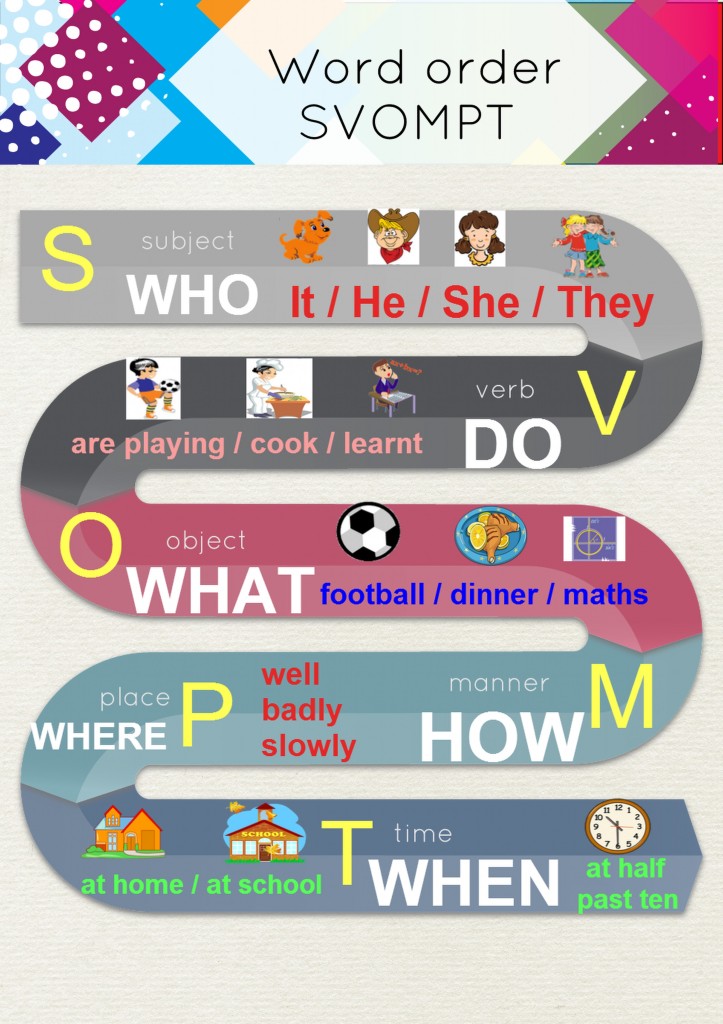
SVOMPT – games and quizzes
If you want to play the quiz on the full screen, click on the button below.
SVOMPT – what is this wordIn the second quiz your task is to put the sentence into the correct order. If you pass this quiz, you can improve your vocabulary in the game called Word Boggle.
If you want to play the quiz on the full screen, click on the button below.
SVOMPT – Arrange the sentenceBoth games and quizzes are in HTML5 so they should play on all mobile devices.
Our most popular post is about questions with HOW. There is another post on all the WH question words. In this post I would like to deal with the questions starting with the word WHAT. To help you with this grammar there is a mind map and two games.
ADVERT:
[showmyads]
Questions with the word WHAT – mind map
There are three set phrases which you should learn by heart: What happened? What is he like? and What does she look like?
The mind map clearly shows the usage of the word WHAT and it is designed in such a way that it can be used as a worksheet too. Your task is to write 10 correct questions starting with WHAT there.
Questions with the word WHAT – games
If you are using a mobile phone click here, to see it on the full screen.
Questions with WHAT – Mobile quizThe second game is in flash and it will play only on desktops. It is called Penalty and your task is to answer the questions and score. Could you be a professional footballer?? 🙂
Questions with WHAT – PenaltyPlacement tests are very important for students of languages. First, they can serve as motivation because they show whether the students improved their knowledge. Second, they help students choose the correct course on their level. And last but not least they inform students how good their English is.
ADVERT:
[showmyads]
However, good placement tests are very expensive and mostly printed. That is why we have decided to create a placement test that will be available for free and in electronic form. The test is in HTML5 so the students will be able to take it on whichever device they have. If you are administering the test, you just tell the students the URL and ask them to show you their results once they have finished. Thus they can do the test on their mobile phones or tablets.
Placement test
If you are taking the test on a mobile device, it might be more comfortable to see it full screen. To get a full screen version of the test, click on the button.
Placement testAs there were some problems with the server, I have added the flash version of the test. It is a bit quicker but it plays only on desktops (no iPads or mobile phones)
Placement test – flashAnd here is another HTML5 version of the test, but it is placed on a different server. So if you experience any problems with the tests above, click here:
Placement test – HTML5Placement test – share
<iframe width=”560″ height=”500″ src=”https://engames.eu/placement test/Placement test_share (Web)/index.html” frameborder=”0″ allowfullscreen></iframe>
To share the link, insert the following code.
https://engames.eu/placement test/Placement test_share (Web)/index.html
Please, do not forget to mention our site https://engames.eu if you share this
Placement test – Print version
And here you can see the key to the placement test:
Placement test – comments
UPDATE: Thank you for your comments. I have added the “Review your answers” option and I have corrected one of the questions. Please, if you spot a mistake, inform me. Please, do not write the number of the question, as the questions are chosen randomly. Thank you very much.
Placement test – updates
If you want to share the test on your site and see your students’ results, contact me at rotreklzdenek_at_gmail_dot_com and I make the test send the results to your e-mail address.
Thank you for helping me improve the test.
I have already dealt with the usage of prepositions in the posts Prepositions AT, IN and ON for time and Adjectives with prepositions. However, this post is different because it concentrates only on the phrases IN THE END, AT THE END, IN TIME and ON TIME which are frequently used incorrectly by students of English. In this post I would like to explain the usage and meaning of the phrases. To achieve this I have created a mind map, an interactive video and two quiz games.
ADVERT:
[showmyads]
Set phrases – mind map
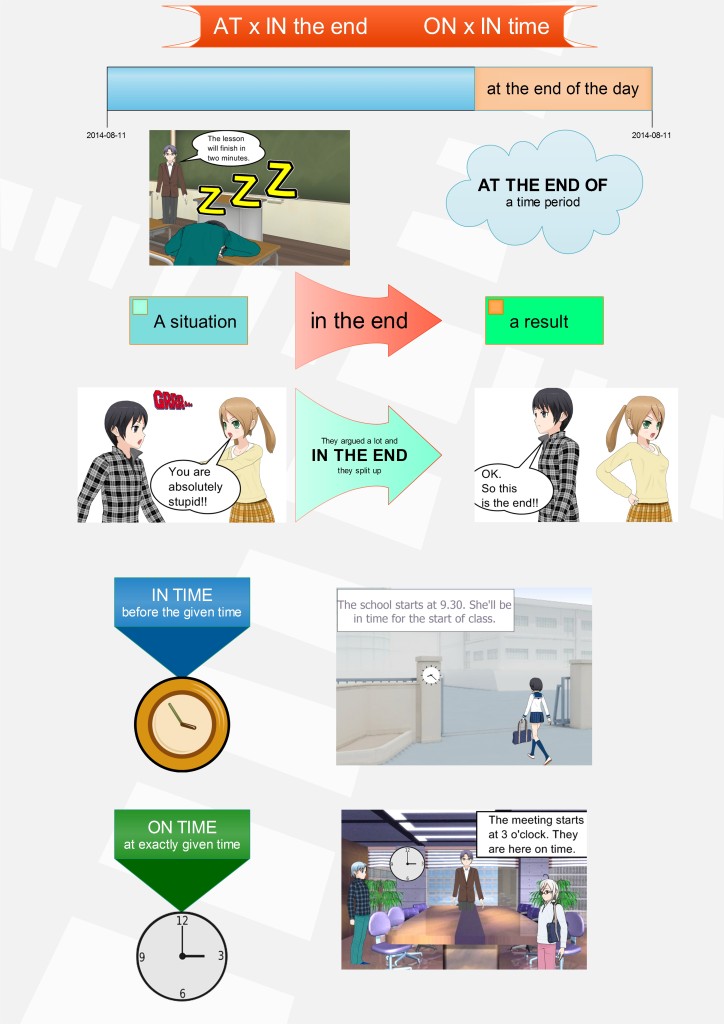
If you feel that this explanation is not clear enough, there is a video explanation which can help you.
Set phrases – interactive video
Set phrases – games
Your task is to complete the quiz with the correct phrases and if you pass you will be given a chance to play the game Word boggle (really great addictive game which might help you improve your English a lot). Set phrases – Word game
The second game will play only on your desktop. It is called Hoopshoot and your task is to choose the correct answer and then score. Good luck.
In this post I would like to teach you how to use the words DESPITE, IN SPITE OF, ALTHOUGH, EVEN THOUGH, BECAUSE OF and BECAUSE correctly. I will explain the meaning of the words and the grammar. To help you with this there are two games, a mind map, a video explanation and a graphical explanation. I hope you will learn to use these conjunctions.
ADVERT:
[showmyads]
Conjunctions – meaning
The meaning of these conjunctions is clearly explained in the following graphics:
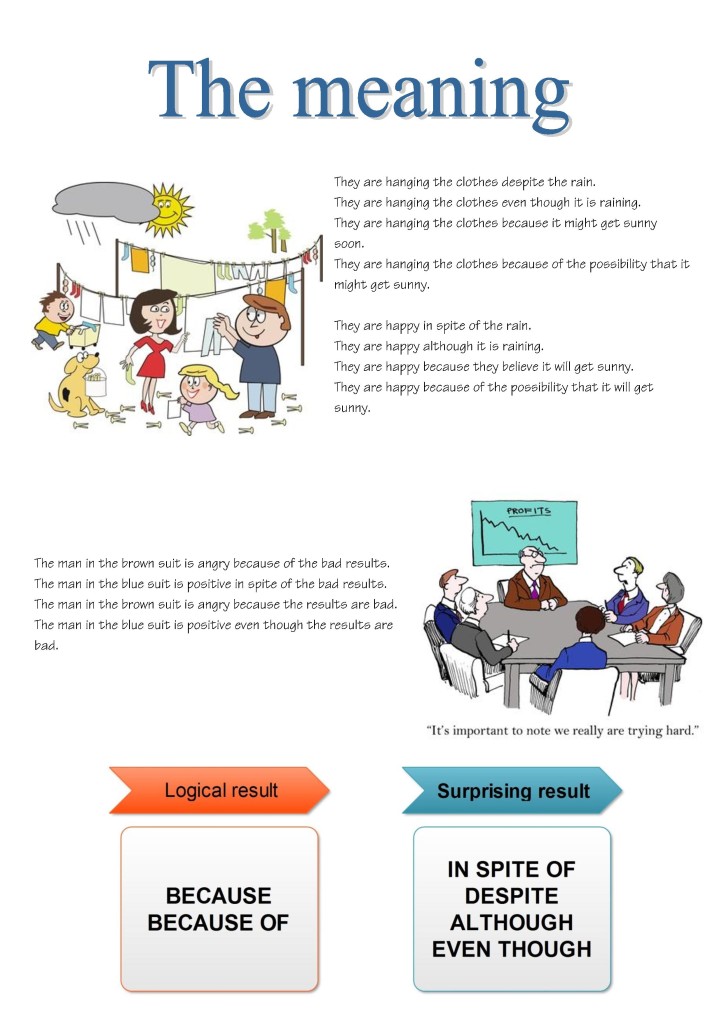
If you want to print out the graphic, you can download the pdf file below:
Conjunctions – the usage
You can see the explanation again in the following mind map:
To make it absolutely clear, here is an interactive video explaining the usage of the words BECAUSE and BECAUSE OF.
This video uses the free recording offered by BBC learning English at http://www.bbc.co.uk/worldservice/learningenglish/radio/specials/165_gramchallenge10/
To experience the video full screen click on the following button (as it is HTML5 video it will work on your mobile too):
BECAUSE – video explanation
ADVERT:
[showmyads]
Conjunctions – quizzes and games
The second quiz is fully in HTML5 so it will play on any mobile device you own. Your task is to connect both of the sentences into one and use the conjunction in the brackets. If you pass the test you will play the game called Math Pop and practise your Maths too.
Conjunctions – quiz and Math pop gameHope, want and would like belong into the group of verbs which are followed by the infinitive. If you click the link above you can see a complete solution for these verbs for intermediate learners of English. In this post we would like to teach how to use only the three verbs HOPE, WANT and WOULD LIKE so it is suitable for elementary learners of English.
We are not going to explain the differences in meaning as these are very small and the best way about them is by consulting a bilingual dictionary. In this post we would like to deal with the grammar of these three verbs (they are followed by the infinitive with TO). There are two games, a mind map and a worksheet to practise or learn the given grammar point.
Verbs followed by TO infinitive – graphic
ADVERT:
[showmyads]

If you are a teacher, you can ask your students to use the mind map above and make as many sentences as they are capable of. Of course, they will have to add some words to start and finish the sentences.
The second graphic features three jokes which contain the target structures and then the students should write their own jokes using the structures given.
Verbs followed by TO infinitive – games
The second game is called Tic-Tac-Toe. Your task is to drag the words into the correct places and then win the game. Place the crosses into such places to have three in a row. There is just one way to win the game. Can you find it?
Verb patterns – tic tac toeWhen students hear the phrase indirect questions, they get scared. But actually this is one of the easiest grammar points in English. The only thing you have to watch out for is that if a sentence starts with a certain phrase (Do you know or Could you tell me etc.) you have to use the word order for an affirmative sentence. To put it simply, after the aforementioned phrases do not make questions.
ADVERT:
[showmyads]
To help you master this grammar there is a mind map, a video and several games in this post.
Indirect questions – video
We recommend that you watch the video and stop the recording every time there is a task and answer the task before MASA does. It is a great fun and a superb way to learn English.
If you want to watch it full screen, click here:
Indirect questions video
Indirect questions – mind map
ADVERT:
[showmyads]
Indirect questions – games
The second game is in Flash and it will play only on your desktop. It is the notorious On target game. If you choose the correct option you will be given a chance to shoot the bad ducks. Moreover, you can get a bonus if you shoot one of the bottles on the sides. Enjoy.
Indirect questions On TargetVocabulary videos
You can learn the words connected with the environment at http://youtu.be/PbBR1sNc6C4
There is a vocabulary video introducing the Town features at http://youtu.be/5Plh_LBjwks
At http://youtu.be/c0T5j-5MEg8 you can learn some vocabulary to speak about Plants in English.
For young learners we have some names of Animals at http://youtu.be/wb6Ctlvz0Ys
If you want to learn more vocabulary on Sports you can go to http://youtu.be/14_5rLiIAm0 and learn the names of Winter Olympics sports
At http://youtu.be/9IWZb61DG1M you can learn Clothes Vocabulary
Furniture vocabulary is presented at http://youtu.be/7VOpE1n74h0
One of the most difficult parts for learners of English to learn are personal qualities.
To help you with this, you can try the video at http://youtu.be/3KisHI5O6WY
Category: English games, Grammar, Intermediate
EFL, English, ESL, games for indirect question, Grammar, grammar games, indirect question, indirect questions explanation, indirect questions grammar, indirect questions mind map, intermediate, intermediate students, learn, learn English, learning English games. English learning games., mind map, school, students, TEFL, TESOL
This is another post in my series of simple grammar explanations for elementary and beginner learners of English. In this post I try to explain the usage of the possessive ‘s and ‘. There is a mind map and several exercises to check the students’ understanding of the grammar.
Possessive case – mind map
ADVERT:
[showmyads]Possessive case – games
If you think you understand the grammar, it is time to check out your understanding in the following games.
The first game is in HTML5 and you can play it on any mobile device you like. Your task is to pass the quiz and if you get more than 70% of all your answers correct you will get a chance to play the game called Angry finches. Good luck.
Possessive case – Quiz (HTML5)The second game is in flash and it will play only on your desktop. Your task is to choose the correct option and then win the fencing duel against the computer. Good luck!
Possessive case – Embed
There have been several requests from people who wanted to share the games on their website. If you think that the html5 quiz is awesome and you would like to share it with the rest of the world on your site, you can do it by embedding the following code on your site:
<iframe src=”https://engames.eu/possessive case/Possessive case_sharable (Web)/index.html” width=”720″ height=”560″></iframe>
Vocabulary for learners of English
Grammar is really important if you want to learn a new language. However, vocabulary is the essence of a language. That is why we have come up with a new site to learn a lot of vocabulary. It is called envocabulary and you can find it at http://www.envocabulary.eu. Enjoy and learn.
Many students struggle with the basic question words even when they are at pre-intermediate level. That is why I have come up with the following post. There is a mind map explaining the meaning of the question words with examples. Then there are two quizzes to practise the question words in a real context.
Question words – mind map
[showmyads]
I think that students should translate the question words into their mother tongue too.
Question words – quizzes
In the first quiz you should complete and create the questions. If you do it well you will get a chance to play several games. The first game is called visual memory and you have to remember all the coloured squares. Can you get over the level 5? I have never managed to get that far. If you pass the second quiz you will play the game Rock, paper and scissors. It is pretty difficult to win against the computer, but it is possible. And if you pass the third quiz you can race on the tracks.
The second quiz is fully in HTML5. If you pass the first quiz, you can play the game Angry finches and if you pass the second quiz you can play the game Tower Defence.
Question words – Quiz (HTML5)Question words – share
<iframe src=”https://engames.eu/question_words/Questionwordsflash_share (Web)/index.html” width=”720″ height=”560″></iframe>
<iframe src=”https://engames.eu/question_words/Questionwords_share2 (Web)/index.html” width=”720″ height=”560″></iframe>
Learn Vocabulary – envocabulary.eu
Category: Elementary, English games, Grammar
A few days ago I wrote a post where I dealt with the mistakes my students made during their final exams. There were six common mistakes which I felt needed explanation and correction.
ADVERT:
[showmyads]
In this post I will deal with six more common mistakes that my students make. Some of them are really elementary but some are more difficult. There is a mind map depicting the mistakes, their correction and an explanation. At the end of the post there are two games to practise the grammar you have learnt.
Common mistakes – mind map
Common mistakes – games
Once you feel confident that you know the correct grammar, it is time to practise the grammar in the following quizzes.
In the first quiz there are several slides with different types of questions. Your task is to correct the mistakes and choose the correct options. If you answer more than 80% of the questions correctly you will get a chance to play the game Tower Defence. In this game you have to set your guards in such a way that they kill all the attackers before they get to your tower. I have passed 2 levels. Will you do better? Both the quiz and the game are in HTML5 so they should play on your mobile device.
Common mistakes – share
<iframe src=”https://engames.eu/common_mistakes/commmistakes2/embed/battle_fillintheblank_game.html” width=”800″ height=”640″ frameborder=”0″ allowfullscreen=”allowfullscreen”></iframe>
To share the game Hoopshoot on your site insert the following code:
<iframe src=”https://engames.eu/common_mistakes/commmistakes2/embed/battle_flashcards_game.html” width=”800″ height=”600″ frameborder=”0″ allowfullscreen=”allowfullscreen”></iframe>
Category: English games, Grammar, Intermediate
As I mentioned before, next year I am going to teach low level students, so I am trying to prepare some materials which I will be able to use with them. A week ago I wrote a post on the verb to be in affirmative and negative sentences. In this post I would like to explain the creation of questions with the verb to be.
[showmyads] In this post there is a mind map showing the usage of the verb to be in questions and then there are several pictures with examples. Under the pictures there is a simple quiz repeating what the students have just learnt. Then there are two quizes to practise the questions and short answers.
Questions with the verb TO BE – mind map
In the short answers you say YES/NO + the pronoun and the verb to be.

In the following picture you can see some examples of the questions:
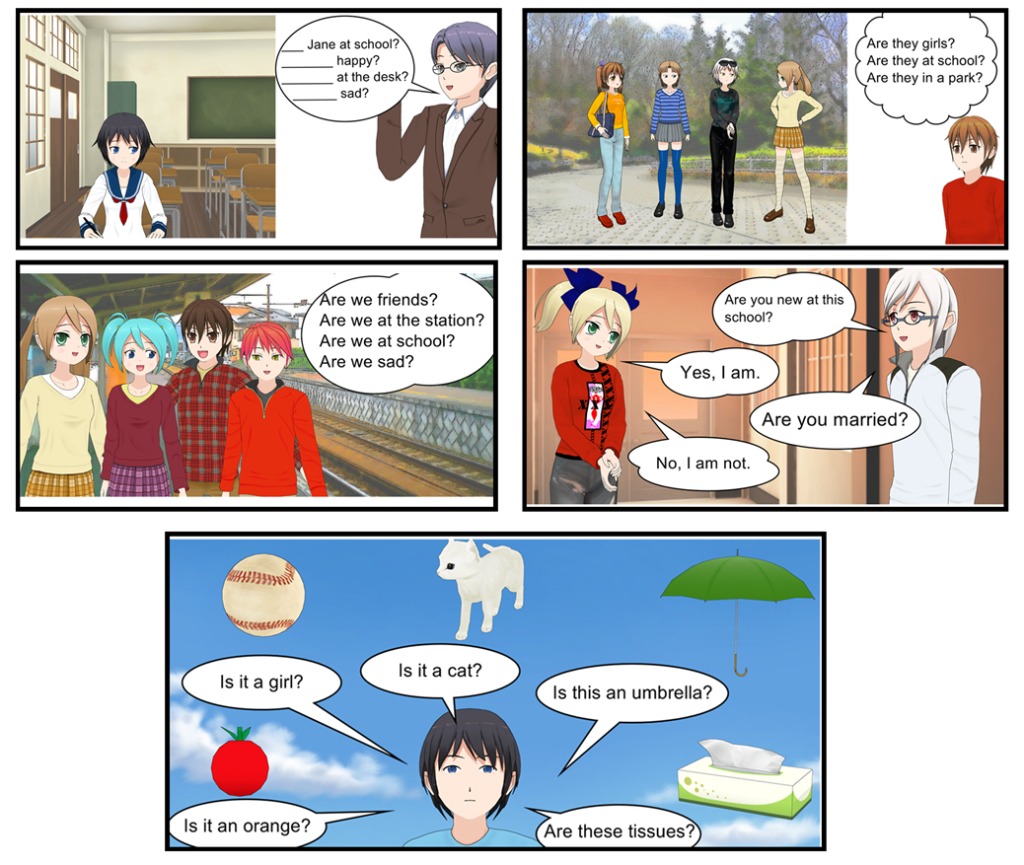
Questions with the verb TO BE – games
[h5p id=”3″]
Questions with the verb to be – quiz
It was really easy, wasn’t is? Let us try something more difficult. Try to complete the questions in the following quiz. If you succeed you will get a chance to play the game Tower Defence. Good luck.
Verb to be – questions quiz
And now it is time to practise your short answers to the questions. Try the following quiz and if you pass it you will have a chance to play the game called Tic-Tac-Toe. Will you win?
Verb to be – short answers
This post is about common mistakes in English. There are two pieces of interesting research into learning and teaching English. One of them says that students learn more if someone else is corrected by the teacher than if they are corrected. The other found out that students learn and remember more vocabulary if the words are not connected in any way (they do not create so called lexical set).
ADVERT:
[showmyads]Combining these two findings it seems logical that students could learn and remember a lot if they were presented with a haphazard collection of someone else’s corrected mistakes. So, during an exam I collected several mistakes which I will present in a mind map and correct them and explain. I hope that students will learn a lot from these.
The post contains a mind map and two games to give the students a chance to learn from the mistakes other students made.
Common mistakes – mind map
Here are six mistakes my students made during an exam. The mistakes are in the bubbles closest to the center. In the second bubble there is the correct version of the given sentence and there is an explanation at the end of each branch.
If you think you will never make these mistakes, you can try the following games:
Common mistakes – games
The first game is an HTML5 quiz. Try to choose only the correct sentences and if you pass the test you can play the game called Tower Defence. Both of these can be played on your mobile phone or iPad.
If you want to display the quiz in a new window click on the button below:
Common mistakes – QuizThe second game will play only on your desktop as it is in Flash. It is called Hoopshoot and your task is to choose a correct sentence and then score a basket. Good luck.
Next school year I am going to teach low level students, so I started to prepare materials for them. The first one deals with the verb to be in affirmative and negative sentences.
The verb to be is the most important verb in English. You need it all the time. That is why solid knowledge of this grammar is vital. Spend your time learning this grammar it will pay off.
ADVERT:
[showmyads]
In this post you will find a mind map and two games for elementary students. I tried to limit the vocabulary, so even a complete beginners would be able to do the exercises.
VERB TO BE – mind map
ADVERT:
[showmyads]
VERB TO BE – games
If you are viewing the post on your mobile device, click on the button below to open the quiz in a new window, which is more comfortable.
The second game is in Flash and thus it will not play on your mobile device. The game is called on Target and your task is to choose the correct form of the verb TO BE and then shoot all the bad ducks. Do not forget that you can get a bonus if you shoot any of the bottles.
In the previous post we could see that verbs usually go with one or more prepositions. In this post we are going to deal with two verbs which can be followed by two different prepositions with different meaning. These verbs are THROW and SHOUT.
ADVERT:
[showmyads]
Both of these verbs can be followed by the prepositions AT or TO but the meaning differs. The differences of meaning are clearly shown in the mind map and at the end of this post there are 2 games to practise these two verbs with their prepositions.
Prepositions – mind map
Prepositions – games
The first game is a HTML5 quiz followed by a Tower Defence game if you pass the test. Good luck
Verbs and prepositions – practise the grammar
The second game is called Teacher Invaders. Your task is to complete the sentences with the prepositions AT and TO and save the planet against the invaders. This game is in Flash and it will not play on mobile devices. Sorry 🙁
Category: English games, Grammar, Intermediate
Are you going to teach or learn the form “BE GOING TO” for expressing future? This post might come handy. There is a mind map explaining all the forms: Affirmative sentences, negative sentences and questions.
This post is especially designed for elementary students who need to learn the form. There are two games to practise the form too.
Be going to – mind map
ADVERT:
[showmyads]

Be going to – games
The first game is called Reaction. Your task is to complete the sentences with be going to and then click on the ugly frog as quickly as you can. The quicker you click the more points you are going to get.
The second game is a quiz. If you answer all the questions correctly you will be able to play the game called Indiara. Good luck.
Yesterday I learnt Spanish and when I tried to reconstruct a text I found out that I do not remember the small words like articles and prepositions. They were so small that I did not pay enough attention to them to remember them.
Interestingly my students have similar problems with prepositions in English. Therefore I have decided to add more posts on prepositions here to help them.
ADVERT
[showmyads]
There have already been several posts on prepositions: Adjectives and prepositions, Nouns and prepositions and verbs and prepositions.
In this post you can find a mind map and two games. Unfortunately the games aren’t mobile friendly.
Verbs and prepositions – mind map
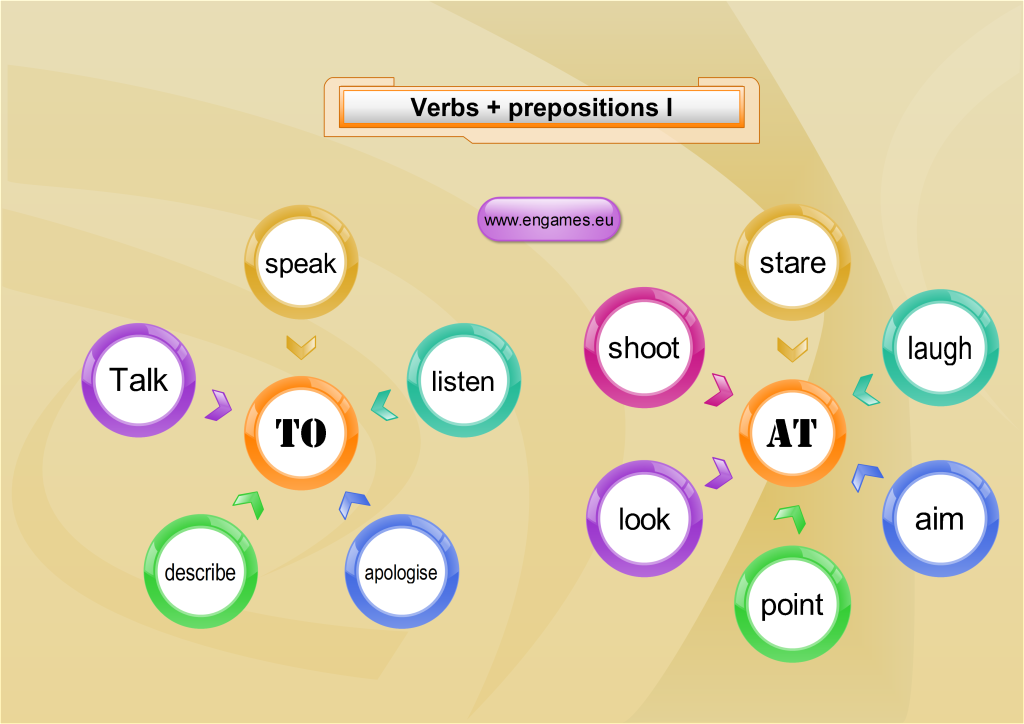
Verbs and prepositions – games
The second game is called Teacher invaders. To stop the invasion you have to shoot all the monsters and complete each sentence with the best preposition available.
Prepositions InvadersCategory: Elementary, English games, Grammar
The greatest thing that can happen to a teacher is the aha! moment when suddenly the students get it. And this happened to me on Thursday. I was teaching the modal verbs of deduction for a hundredth time and suddenly the students could understand it and use it correctly. Wonderful feeling!!!
ADVERT:
[showmyads]
In this post I would like to share all the materials I used in the lesson. There is a mind map and two games. Moreover, for the teachers of English there is a hand out for an activity called pair cards.
Modals of deduction – mind map
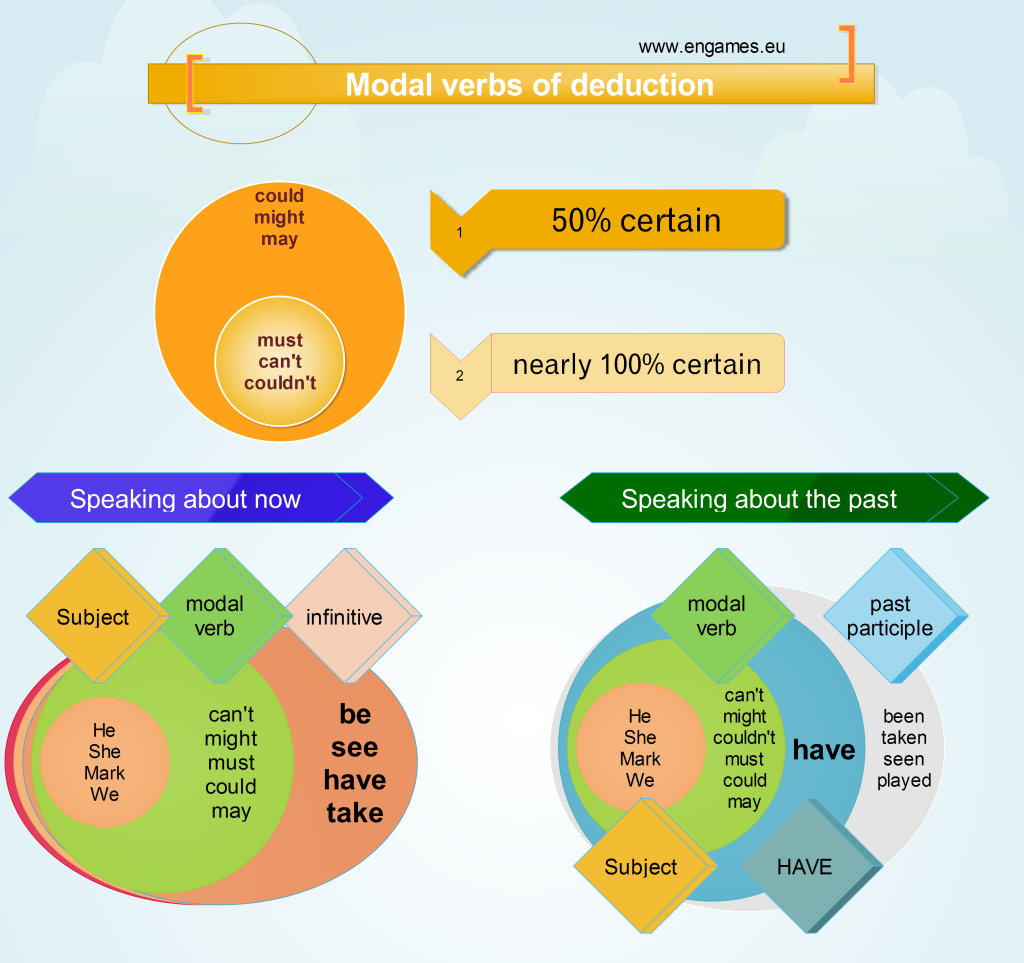
The meaning of the modals is often influenced by the context. These mathematical expressions of the meaning should be understood in context. By these modal verbs the speaker expresses how certain he is about the given thing .
Modals of deduction – games
ADVERT:
[showmyads] In the first quiz you should complete the second sentence is such a way that its meaning will be the same as the first sentence. Sometimes more than one answer is correct however you have to use the modal verbs of deduction all the time. If you pass the test you can try our new game called Tower defence.
In the second quiz you should do the same as in the first one. However, this time if you pass the test, you will be given a chance to play the game Angry finches. Good luck 🙂
Modals of deduction – for teachers
Cut the worksheet into four different cards. Ask the students to work in pairs and give each student one of the cards. Make sure that each student in the pair has a different card.
On each card some sentences are blue and some are white. The blue ones are the correct answers and the white ones are the students’ task.
Students work in pairs and they read their white sentences and complete the one with the gap in such a way that it has the same meaning as the first one. Their partner listens to them and checks their answer in the blue sentences.
Students take turns and go through the whole cards. Students do not write anything! They just read their answers so they can swap the cards and do the same if they get to the end.
Students often use the wrong prepositions. So I have created this post in hope that this short explanation and practise will help them get at least some of the prepositions correct.
ADVERT
[showmyads]
Many teachers claim that students use prepositions incorrectly because of interference from their mother tongue. It is true in many cases but I think it is not the main reason. I believe that students confuse prepositions mainly because these small words often do not hinder communication. Even if students use the prepositions wrongly most of the time, people can still understand them.
In this post students will get a chance to learn some basic nouns + prepositions. To achieve this goal there is a mind map depicting basic nouns + prepositions. Then, there are three games where you can practise what you have learnt in the mind map.
Nouns and prepositions – mind map
ADVERT:
[showmyads]
You have probably noticed that several words are used with more than one preposition. In some cases there is a difference in meaning and in others there are none. Let’s have a look at these words:
Advantage of / in / to – the meaning is the same.
A relationship / a connection / a contact with – with one noun.
A relationship / a connection / a contact between – between two things or people
An attitude to / towards – both have the same meaning.
Nouns and prepositions – game
En Garde game
The third game is called Teacher invaders and your task is to protect your planet against the invaders. And from time to time you have to complete the sentence with a correct preposition.
Many students struggle with reported speech. They feel that there are many rules they have to follow and they often get confused.
In this post I try to simplify the rules about the reported speech (or indirect speech) as much as possible. There is mind map describing the basic rules, a video and two games to practise the grammar.
ADVERT:
[showmyads]
To put it simply, reported speech is used when you start a sentence with an expression like She said or He told me etc. Then you have to move the verbs backwards. Thus you change the present simple tense into past simple. You change the past continuous to past perfect continuous and so on (see the mind map for more details).
Reported speech – video
Reported speech – mind map
First of all, reported speech happens after the reporting verbs (said, told, claimed etc.) in past tense. Then you have to move the original verb from the direct speech. The changes are depicted below.
The most common changes are depicted in the lower part of the mind map. If there are the verbs ARE, IS, WILL, CAN, HAVE or DO in the direct speech, just change them as shown and you do not have to do anything else.
ADVERT:
[showmyads]
Reported speech – games
Download the following pdf file and open it with Acrobat Reader, otherwise the game will not work.
The second game is a quiz. You will see the direct speech and your task is to complete the reported speech sentence correctly. If you pass the quiz you can play the game Indiara. All of these are in HTML5 so they should play on your mobiles without the slightest problem.
Many verbs in English are often followed by the same preposition. Therefore it is best to learn them togehter from the beginning. However, even if you do this it is neccessary to sum it up from time to time.
ADVERT
[showmyads]The following summary was created for my elementary students of English and it contains the verbs they know which are often followed by the prepositions FOR, ABOUT, AT and TO.
In this post you can find a mind map and two games to practise the usage of the given preposition.
Prepositional pharses – mind map
The following mind map graphically shows the verbs which are used with the prepositions FOR, ABOUT, TO and AT.
Verbs and prepositions – games
Once you memorise all the verbs and prepositions that follow them you can try the following games. In the first game you should complete the sentences with the correct preposition. If you succeed you can play the game Highway Race. In this game you try to avoid all the cars on the highway. The best result has been 50,000 points. Can you do better?
The second game is a classic. It is called Teacher Invaders and your task is to shoot all the invaders before they destroy the whole planet. However, from time to time the game is interrupted and you have to complete a sentence with the correct preposition. Good luck.
More posts on prepositions
If you liked this post and you feel that you need to practise the prepositions more you might like the following posts on our site.
Do you think that we should create some more posts? Please leave a comment and we might do it.

